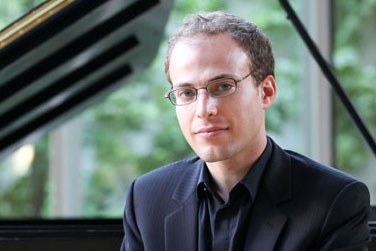|
Symphony
SRS SEASON ENDS WITH RESOUNDING TA-TA-TA-BANG
by Terry McNeill
Sunday, June 1, 2025
Symphony
YOUTHFUL VIRTUOSITY ON DISPLAY AT USO'S MAY CONCERTS
by Peter Lert
Saturday, May 17, 2025
Symphony
MYSTICAL PLANETS AND LIVELY GERSHWIN ORTIZ AT FINAL SRS CONCERT
by Peter Lert
Sunday, May 4, 2025
Symphony
VSO'S CONCERT MUSIC OF TIME, MUSIC OF PLACE
by Peter Lert
Sunday, April 27, 2025
Choral and Vocal
VOCAL ELEGANCE AND FIRE AT THE 222'S RECITAL APRIL 26
by Pamela Hicks Gailey
Saturday, April 26, 2025
CANTIAMO SONOMA SINGS AN INSPIRED GOOD FRIDAY MOZART REQUIEM CONCERT
by Pamela Hicks Gailey
Friday, April 18, 2025
DRAMATIC SHOSTAKOVICH SYMPHONY CLOSES PHILHARMONIC'S 25TH SEASON
by Terry McNeill
Sunday, April 13, 2025
LARGE COLLEGE OF MARIN AUDIENCE GREETS STOPHER ARTISTRY
by Terry McNeill
Saturday, April 5, 2025
Chamber
FRISSON DELIVERS SHIVERS OF DELIGHT
by Abby Wasserman
Sunday, March 30, 2025
OLD AND MOSTLY NEW IN SRS MARCH CONCERT IN WEILL
by Peter Lert
Saturday, March 22, 2025
|
 |
 Pianist Orion Weiss |
ORION WEISS TAKES BARTÓK AT THE SPEED OF LIGHT
by Steve Osborn
Sunday, November 6, 2016
Gifted pianists are everywhere these days, but few have the prodigious speed, stamina, and musicality of Orion Weiss. He exhibited all these qualities in a memorable rendition of Béla Bartók’s second piano concerto with the Santa Rosa Symphony Nov. 6 in Weill.
Weiss is a no-nonsense pianist. He seated himself at the piano, gathered his energies, and then launched full bore into the finger-crunching opening runs of the Bartók. He spent nearly all his time staring at his hands, as if guiding his fingers with his eyes rather than his arms. The speed of light seems like the most plausible explanation for the astonishing rapidity and precision of his attack. He was able to control the resonance of the piano with finger speed as much as pedal. In one soft passage, he achieved a haunting effect by striking the keys with so much speed that the notes died away as soon as they sounded.
The Bartók requires a considerable amount of fire from the soloist, an element that Weiss has in profusion. Although he was occasionally drowned out by the winds in the Allegro first movement, he flamed forth time and again, fully igniting near the end with an incredibly fast cadenza.
The entry of muted strings in the second movement brought an entirely new world of sound, to hypnotic and engaging effect. Weiss arose out of this background by producing tremendous volume from his instrument, accented by a beguiling duet with tympani. The tympani featured prominently in the final movement as well, along with a booming bass drum. Much of the movement is given over to a vigorous call-and-response between piano and orchestra. Weiss not only matched each orchestral outburst but kept raising the ante all the way to the transcendent conclusion.
The opener, Liszt’s symphonic poem “Les Préludes,” stood in pale contrast to Bartók’s masterpiece. Liszt’s orchestration is competent, but his melodies are insipid and his development evanescent. Nonetheless, the orchestra played flawlessly under conductor Bruno Ferrandis, with elegant solos from the French horn and oboe. After an interminable series of runs and arpeggios, the melodic material does coalesce near the end with a striking nine-note descending figure from the brass, impeccably executed by the orchestra’s trumpets and trombones.
Schumann’s second symphony, which occupied the latter part of the program, is a standard of the repertoire, and with good reason. Every movement has striking melodies and motifs, and they flow together with consummate grace. The orchestra played superbly, but special praise must be given to the string section, which negotiated Schumann’s roller-coaster runs with accuracy, unanimity and feeling. Nary a wrong note was to be heard.
In the first movement, Schumann uses a dizzying array of short motifs to build a central theme. Ferrandis brought out the abundant phrases and syncopations, nowhere more so than in an extended passage for strings and clarinet. The violins shone in the second movement, a playful Scherzo that requires nearly perpetual motion, capped off by a bracing sprint to the finish.
The players caught their breath in the subsequent Adagio, a subdued and calming interlude that invites rhythmic flexibility and heartfelt playing, which were everywhere in evidence. Most notable was the beautiful Bach-tinged fugue in the middle.
Ferrandis set a brisk tempo for the Allegro molto finale, resorting sometimes to compact angular motions instead of a more relaxed fluidity. However the beat was conveyed, the musicians kept up the pace while deftly handling repeated sforzandos and orchestral swells. Each idea led seamlessly into the next and propelled toward a triumphant ending — triumphant not only for Schumann, but also for Ferrandis and the Santa Rosa Symphony, which delivered an outstanding performance.
[Reprinted by permission of San Francisco Classical Voice.]
|
